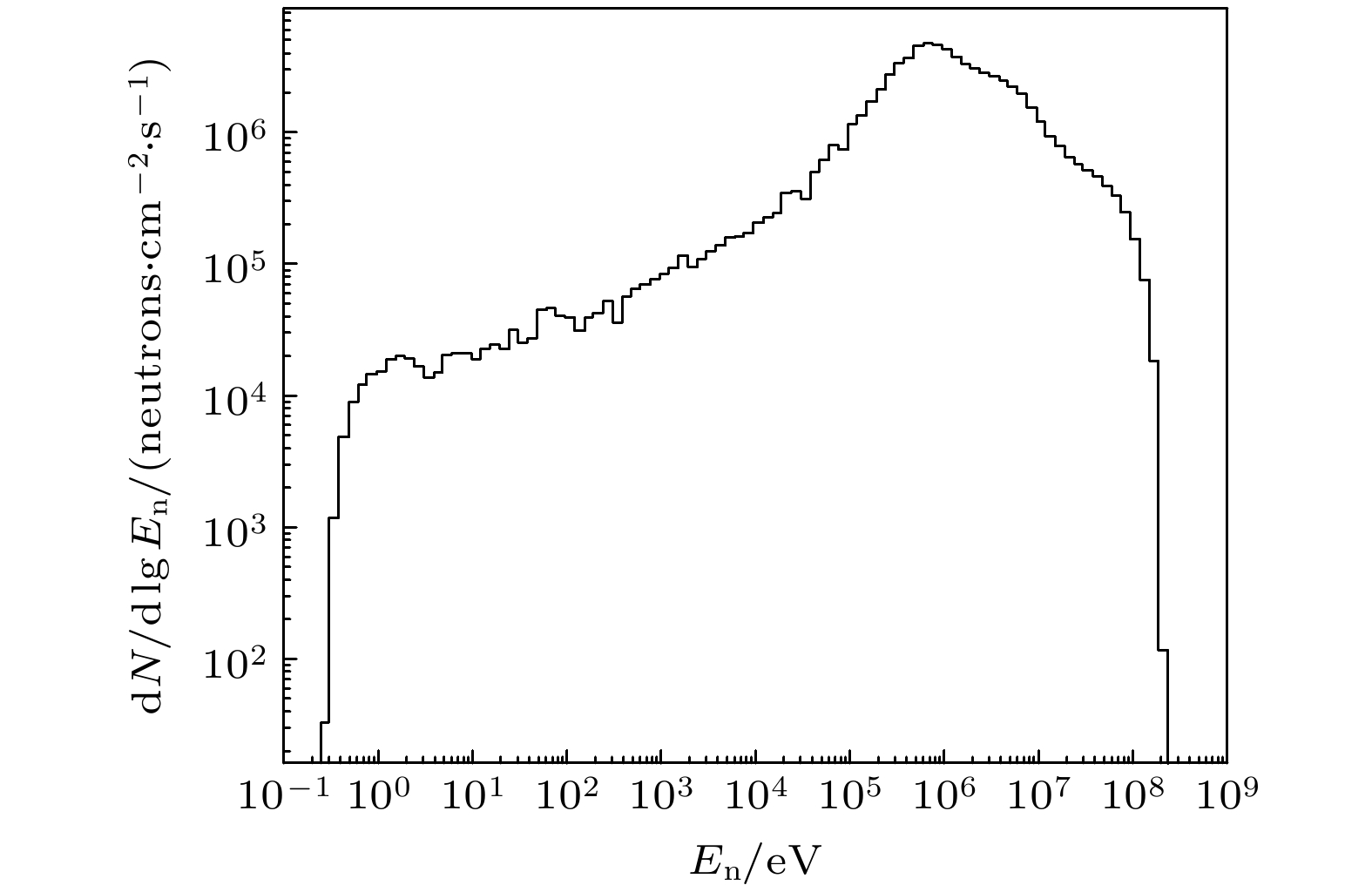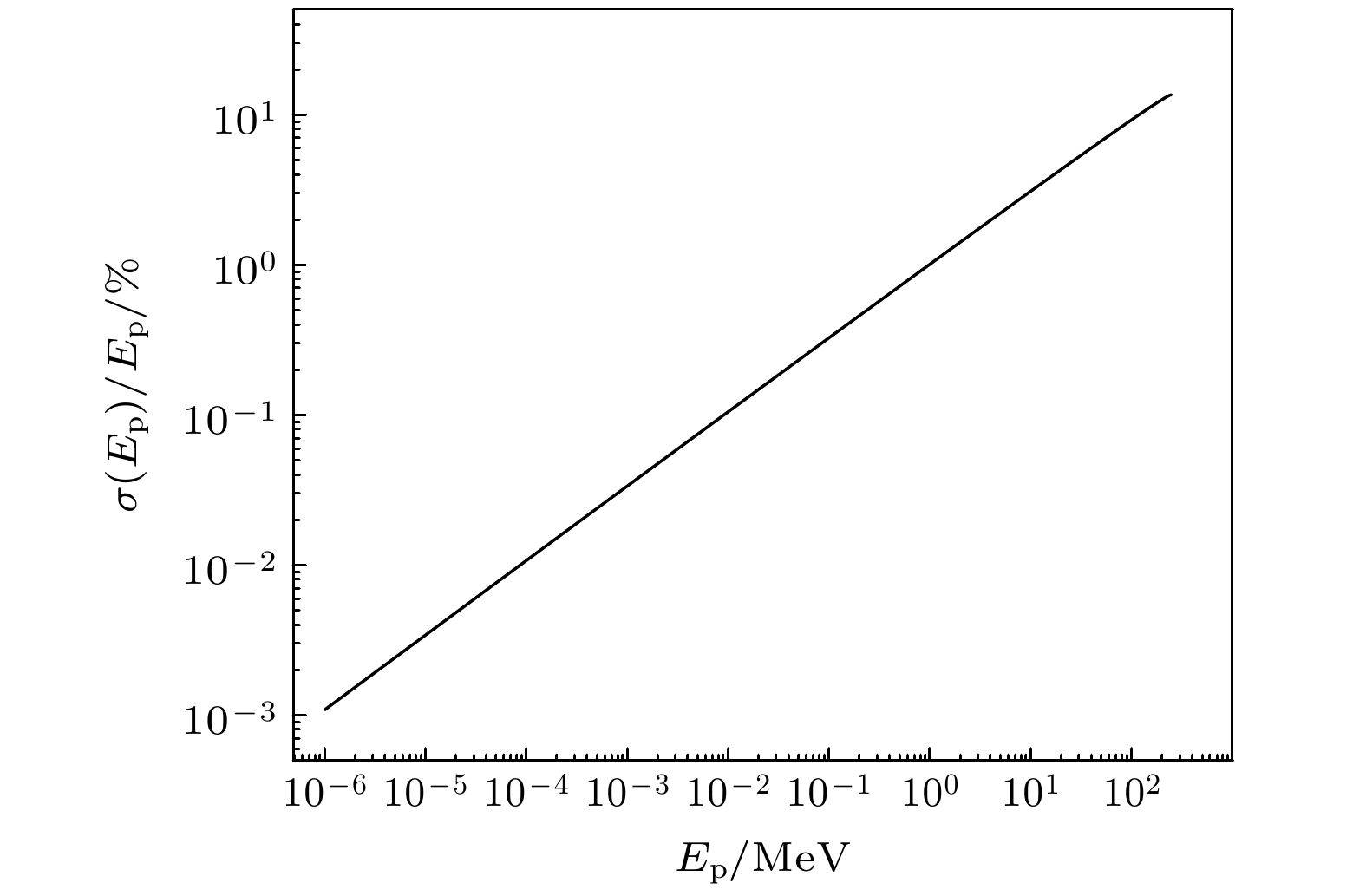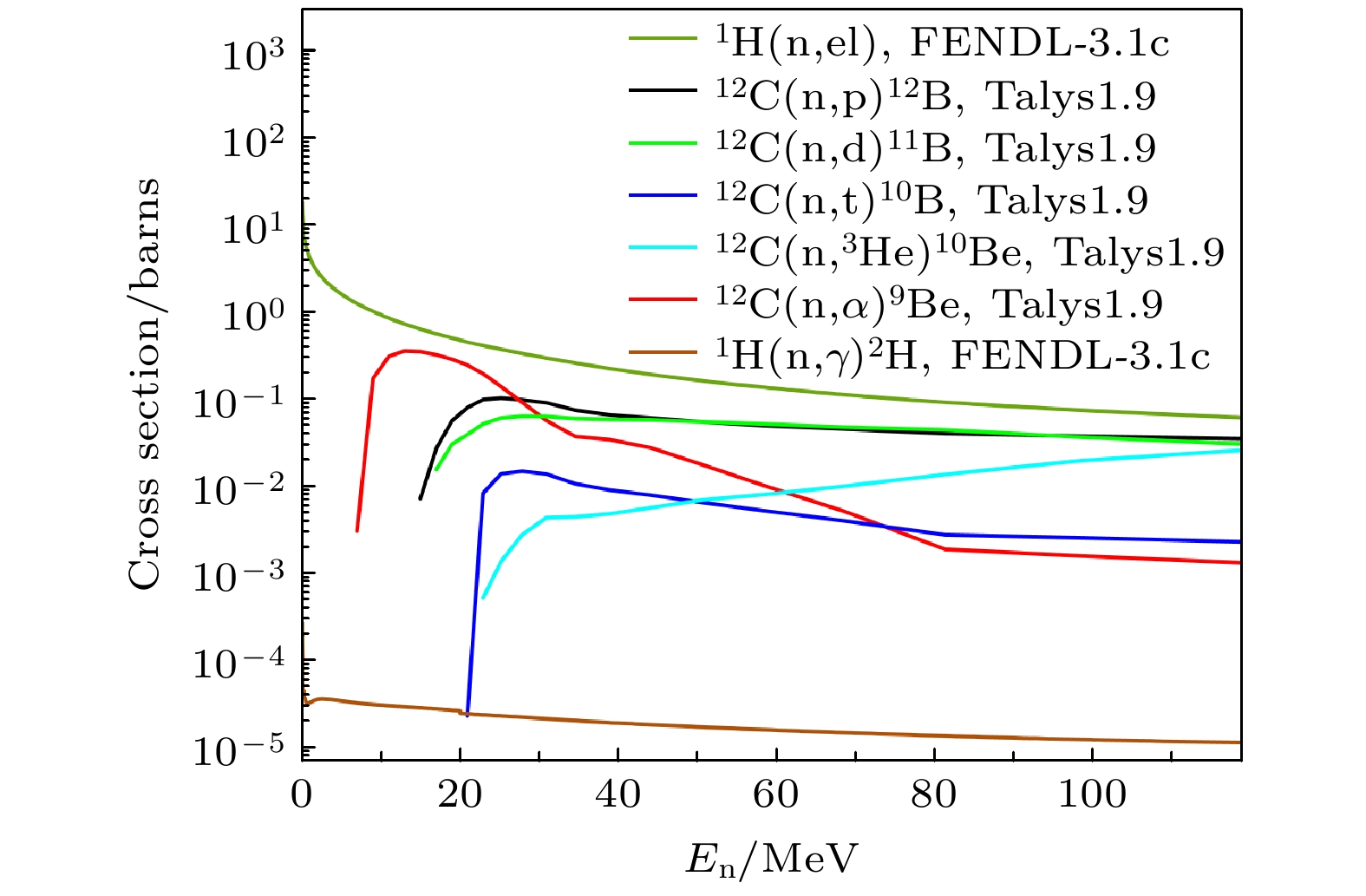-
目前国内外的质子标定终端较少, 且普遍为单能质子束流. 基于中国散裂中子源的反角白光中子源的eV—200 MeV中子能量区间的白光中子束流, 以及中子与氢的1H(n, el)反应, 可以获得宽能谱的能量连续次级质子. 利用1 GSps采样率、12 bit的波形数字化获取系统采集探测器输出波形信号, 通过对波形信号的分析, 得到中子及反冲质子的飞行时间, 进而得到反冲质子的动能. 利用该方法得到的质子, 为探测器质子标定等研究提供了新的研究平台. 在该研究平台已经开展了带电粒子望远镜的标定实验. 研究了CsI (Tl)探测器不同的信号读出方式对望远镜的ΔE-E二维谱、幅度-质子动能二维谱等粒子鉴别方法得到的粒子鉴别的效果, 得到了较优的探测器信号读出方案. 该研究为带电粒子望远镜的建设提供了实验依据, 也说明了基于反角白光中子源的宽能谱质子标定的可行性.
-
关键词:
- 质子标定 /
- 探测器 /
- 1H(n, el)反应 /
- 反角白光中子源
At present, there exist few proton-beam terminals for the detector calibration in the world. Meanwhile, most of these terminals provide monoenergetic protons. Back-n white neutron source from China Spallation Neutron Source(CSNS) was put into operation in 2018. Based on the white neutron flux ranging from 0.5 eV to 200 MeV from the CSNS Back-n white neutron source, continuous-energy protons involved in a wide energy spectrum can be acquired from the 1H(n, el) reaction. Adopting this method, a new research platform for researches such as proton calibration is realized at CSNS. As hydrogen exists as gas at normal temperature and pressure, in the selecting of the proton-converting target, the hydrogen-rich compounds are preferential considered. Considering the reaction cross sections of the 1H(n, el), 12C(n, p)12B, 12C(n, d)11B, 12C(n, t)10B, 12C(n, 3He)10Be, 12C(n, α)9Be and 1H(n, γ)2H, polyethylene and polypropylene are suitable for serving as targets in this research. Based on a 3U PXIe, digitizers with 1 GSps sampling rate and 12 bit resolution are utilized to digitize and record the output signals of telescopes. The time and amplitude information of each signal are extracted from its recorded waveform. Proton fluxes can be calculated by using the neutron energy spectrum and the cross section of the 1H(n, el) reaction. Using the γ-flash event as the starting time of the time-of-flight (TOF) and the time information of signal in detector as the stopping time, the kinematic energy of each secondary proton can be deduced from the TOF and the angle of the detector. A calibration experiment on three charged particle telescopes, with each telescope consisting of a silicon detector and a CsI(Tl) detector, is carried out on this research platform. The readout methods of the CsI(Tl) detectors in these three telescopes are different. In the calibration experiment, ΔE-E two-dimensional spectra and amplitude-Ep two-dimensional spectra of these telescopes are obtained. Through comparing these particle identification spectra, the SiPM is chosen as the signal readout method for CsI(Tl) detectors in the charged particle telescopes. These researches provide experimental evidence for the construction of the charged particle telescope at Back-n, and also illustrate the feasibility of wide-energy spectrum proton calibration based on the Back-n white neutron source.-
Keywords:
- proton calibration /
- detector /
- 1H(n, el) reaction /
- back-n white neutron source
[1] Casolino M, Bidoli V, Minori M, et al. 2006 Adv. Space Res. 37 1691
 Google Scholar
Google Scholar
[2] Makek M, Achenbach P, Ayerbe Gayoso C, et al. 2012 Nucl. Instrum.Meth. A 673 82
 Google Scholar
Google Scholar
[3] Jakubek J 2011 Nucl. Instrum. Meth. A 633 S262
 Google Scholar
Google Scholar
[4] 葛涛, 张天爵, 吕银龙, 等 2019 原子能科学技术 53 1547
 Google Scholar
Google Scholar
Ge T, Zhang T J, Lv Y L, et al. 2019 Atomic Energy Science and Technology 53 1547
 Google Scholar
Google Scholar
[5] An Q, Bai H Y, Bao J, et al. 2017 J. Instrum.n 12 07022
 Google Scholar
Google Scholar
[6] Tang J Y, Fu S N, Jing H T, et al. 2010 Chin. Phys. C 34 121
 Google Scholar
Google Scholar
[7] 唐靖宇, 敬罕涛, 夏海鸿, 等 2013 原子能科学技术 47 1089
 Google Scholar
Google Scholar
Tang J Y, Jing H T, Xia H H, et al. 2013 Atomic Energy Science and Technology 47 1089
 Google Scholar
Google Scholar
[8] 唐靖宇, 安琪, 白怀勇, 等 2019 原子能科学技术 53 2012
 Google Scholar
Google Scholar
Tang J Y, An Q, Bai H Y, et al. 2019 Atomic Energy Science and Technology 53 2012
 Google Scholar
Google Scholar
[9] Chen Y, Luan G, Bao J, et al. 2019 Eur. Phys. J. A 55 115
 Google Scholar
Google Scholar
[10] 鲍杰, 陈永浩, 张显鹏, 等 2019 物理学报 68 080101
 Google Scholar
Google Scholar
Bao J, Chen Y H, Zhang X P, et al. 2019 Acta Phys. Sin. 68 080101
 Google Scholar
Google Scholar
[11] Zhang D, Cao P, Wang Q, et al. 2017 Chin. Phys. C 41 026102
 Google Scholar
Google Scholar
[12] FENDL-3.1 c: Fusion Evaluated Nuclear Data Library Ver.3.1 c: https://www-nds.iaea.org/fendl/[2020-10-18]
[13] TALYS: https://tendl.web.psi.ch/tendl_2019/talys.html [2020-8-20]
[14] Jiang W, Ye Y L, Lin C J, et al. 2020 Phys. Rev. C 101 031304(R
 Google Scholar
Google Scholar
[15] Chen J, Lou J L, Ye Y L, et al. 2018 Phys. Lett. B 781 412
 Google Scholar
Google Scholar
[16] Pirrie S, Wheldon C, Kokalova Tz, et al. 2020 Phys. Rev. C 102 064315
 Google Scholar
Google Scholar
[17] EJ-550: https://eljentechnology.com/products/accessories/ej-500[2020-11-10]
[18] Sensl: https://www.onsemi.com/PowerSolutions/parametrics /17940/products[2020-6-5]
[19] S3590-08: https://www.hamamatsu.com/jp/en/product/type/ S3590-08/index.html[2020-6-17]
[20] Jiang W, Bai H Y, Jiang H Y, et al. 2020 Nucl. Instrum. Meth. A 973 164126
 Google Scholar
Google Scholar
[21] Jiang H Y, Jiang W, Cui Z Q, et al. 2021 Eur. Phys. J. A 57 6
[22] Fan R, Jiang H Y, Jiang W, et al. 2020 Nucl. Instrum. Meth. A 981 164343
 Google Scholar
Google Scholar
-
图 6 CsI (Tl)探测器的测试与标定实验所用探测器及读出方式 (a) 使用光学硅脂耦合的CsI (Tl)探测器+SiPM读出方式; (b) 使用的SiPM; (c) 使用光学硅脂耦合的CsI (Tl)探测器+PD读出方式; (d)使用的PD
Fig. 6. The CsI (Tl) detectors and readout methods used for the calibration experiment: (a) The optical silicon-grease coupled CsI (Tl) detector +SiPM readout method; (b) the SiPM used in the experiment; (c) the optical silicon-grease coupled CsI (Tl) detector +PD readout mode; (d) the PD used in the experiment.
表 1 对于不同中子能区, Back-n实验厅二中心位置处的反冲质子流强(束流功率为100 kW)
Table 1. Proton fluxes at the center of Back-n ES #2 in different energy regions at 100 kW.
中子能量区间 中子通量/(s–1·cm–2) 反冲质子流强/s–1 * 0.1 — 1.0 eV 4.08 × 103 1.75 × 102 1 — 10 eV 1.79 × 104 7.68 × 102 10—100 eV 3.01 × 104 1.30 × 103 0.1 —1.0 keV 5.01 × 104 2.15 × 103 1 — 10 keV 1.23 × 105 5.14 × 103 10 — 100 keV 4.30 × 105 1.44 × 104 0.1— 1.0 MeV 2.98 × 106 4.57 × 104 1 — 10 MeV 2.77 × 106 1.56 × 104 10 — 40 MeV 4.62 × 105 6.01 × 102 40 — 70 MeV 9.93 × 104 3.48 × 101 70 — 100 MeV 4.10 × 104 8.54 × 100 100 — 130 MeV 1.65 × 104 2.32 × 100 130 — 160 MeV 6.14 × 103 7.53 × 10-1 160 — 200 MeV 1.63 × 103 1.99 × 10-1 总计 7.03 × 106 8.59 × 104 注: *束斑直径为Φ60 mm, 利用10 μm厚的聚乙烯薄膜作为靶. -
[1] Casolino M, Bidoli V, Minori M, et al. 2006 Adv. Space Res. 37 1691
 Google Scholar
Google Scholar
[2] Makek M, Achenbach P, Ayerbe Gayoso C, et al. 2012 Nucl. Instrum.Meth. A 673 82
 Google Scholar
Google Scholar
[3] Jakubek J 2011 Nucl. Instrum. Meth. A 633 S262
 Google Scholar
Google Scholar
[4] 葛涛, 张天爵, 吕银龙, 等 2019 原子能科学技术 53 1547
 Google Scholar
Google Scholar
Ge T, Zhang T J, Lv Y L, et al. 2019 Atomic Energy Science and Technology 53 1547
 Google Scholar
Google Scholar
[5] An Q, Bai H Y, Bao J, et al. 2017 J. Instrum.n 12 07022
 Google Scholar
Google Scholar
[6] Tang J Y, Fu S N, Jing H T, et al. 2010 Chin. Phys. C 34 121
 Google Scholar
Google Scholar
[7] 唐靖宇, 敬罕涛, 夏海鸿, 等 2013 原子能科学技术 47 1089
 Google Scholar
Google Scholar
Tang J Y, Jing H T, Xia H H, et al. 2013 Atomic Energy Science and Technology 47 1089
 Google Scholar
Google Scholar
[8] 唐靖宇, 安琪, 白怀勇, 等 2019 原子能科学技术 53 2012
 Google Scholar
Google Scholar
Tang J Y, An Q, Bai H Y, et al. 2019 Atomic Energy Science and Technology 53 2012
 Google Scholar
Google Scholar
[9] Chen Y, Luan G, Bao J, et al. 2019 Eur. Phys. J. A 55 115
 Google Scholar
Google Scholar
[10] 鲍杰, 陈永浩, 张显鹏, 等 2019 物理学报 68 080101
 Google Scholar
Google Scholar
Bao J, Chen Y H, Zhang X P, et al. 2019 Acta Phys. Sin. 68 080101
 Google Scholar
Google Scholar
[11] Zhang D, Cao P, Wang Q, et al. 2017 Chin. Phys. C 41 026102
 Google Scholar
Google Scholar
[12] FENDL-3.1 c: Fusion Evaluated Nuclear Data Library Ver.3.1 c: https://www-nds.iaea.org/fendl/[2020-10-18]
[13] TALYS: https://tendl.web.psi.ch/tendl_2019/talys.html [2020-8-20]
[14] Jiang W, Ye Y L, Lin C J, et al. 2020 Phys. Rev. C 101 031304(R
 Google Scholar
Google Scholar
[15] Chen J, Lou J L, Ye Y L, et al. 2018 Phys. Lett. B 781 412
 Google Scholar
Google Scholar
[16] Pirrie S, Wheldon C, Kokalova Tz, et al. 2020 Phys. Rev. C 102 064315
 Google Scholar
Google Scholar
[17] EJ-550: https://eljentechnology.com/products/accessories/ej-500[2020-11-10]
[18] Sensl: https://www.onsemi.com/PowerSolutions/parametrics /17940/products[2020-6-5]
[19] S3590-08: https://www.hamamatsu.com/jp/en/product/type/ S3590-08/index.html[2020-6-17]
[20] Jiang W, Bai H Y, Jiang H Y, et al. 2020 Nucl. Instrum. Meth. A 973 164126
 Google Scholar
Google Scholar
[21] Jiang H Y, Jiang W, Cui Z Q, et al. 2021 Eur. Phys. J. A 57 6
[22] Fan R, Jiang H Y, Jiang W, et al. 2020 Nucl. Instrum. Meth. A 981 164343
 Google Scholar
Google Scholar
计量
- 文章访问数: 9703
- PDF下载量: 160
- 被引次数: 0














 下载:
下载:







